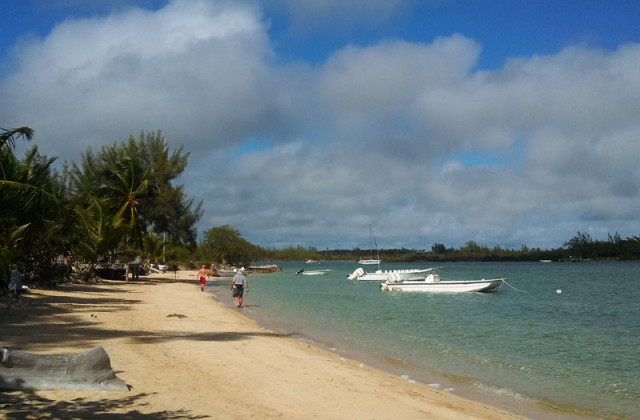A Really Tough Class: Studying Geology in the Bahamas
Which course offers sun, sand, and a clear turquoise sea — in January? It’s the “Coral Reefs and Caves: The Geology of The Bahamas” course in the Environmental Sciences & Policy program. I took it this year and can confirm it’s just as good as it sounds, although it’s not all fun and games (we did have a few exams). I asked Kathy Schubel how she got the idea to offer this class.
But first, why it’s as good as it sounds: The course consists of a week of online units and a week in The Bahamas. From the field station on Andros Island, we took a small boat to many small islands or cays (pronounced “keys”); saw one of two places in the world where ooid sand forms; explored Captain Morgan’s Cave (no rum present); snorkeled and saw lots of coral reefs and fish, including lionfish (an invasive species); saw mangroves and swam in blue holes (Andros has the most blue holes in the world — 178 on land and more than 50 in the ocean). Oh, and we had great weather — sunny, with temperatures in the high 70s.
We saw evidence of higher sea levels in past millennia, walked over lithified sand dunes, and saw carbonate crusts being formed on rocks in the intertidal zone. Schubel calls the area “the carbonate factory,” and after a week I did get a sense of how the geology there works and how it created what we see today.

Andros Island (just left of center) is the largest in The Bahamas. (Image from travel.state.gov)
It was a treat to snorkel and be able to see coral reefs, not only because they are beautiful and colorful, but also because they’re fragile environmental indicators, vulnerable to the changing climate, ocean acidification, pollution and other — mostly human-caused — impacts. Seeing them made the reefs’ predicament more real for me.
The class was a blast — and a great learning experience. So how did this amazing field course come about? Schubel, who has taught the Bahamas course for six years and hopes to offer it again in 2014, explained.
Q: How did you get the idea for the Bahamas class? Had you been down there before?
A: “Susie Creamer, who is a graduate of the program and has been the TA for the course since it began, came to me and said that she thought the program needed an international component. She challenged me to come up with a class. I had taught an undergraduate course in the Bahamas a number of times in the past. I knew the island well and it made it easy to put together a course for JHU students.”
Q: What’s your favorite part of teaching the class?
A: “I love being out in the field with students. We can read about and discuss topics, but there is nothing like seeing things first-hand. That is when the magic happens. That’s when things may suddenly all make sense. Andros Island is a large island by Bahamian standards. There are so many different carbonate sedimentary environments (coral reefs, sandy tidal flats, muddy tidal flats, ooid sand shoals, etc) and karst features represented. It’s the best place I know to get a comprehensive overview of all of these settings.”
Q: What would you tell students who are hesitant to sign up because they’ve never been snorkeling before?
A: “Not to worry. If you can swim I can teach you to snorkel. Snorkeling is really just swimming for lazy people. It doesn’t require a whole lot of physical exertion. If you have a wetsuit on you’ll be nice and buoyant and then it’s a matter of kicking a bit. Your arms are largely just along for the ride.”
Dan Kulpinski still considers himself a beginning snorkeler. He will graduate from the M.S. Environmental Sciences & Policy program in May.


